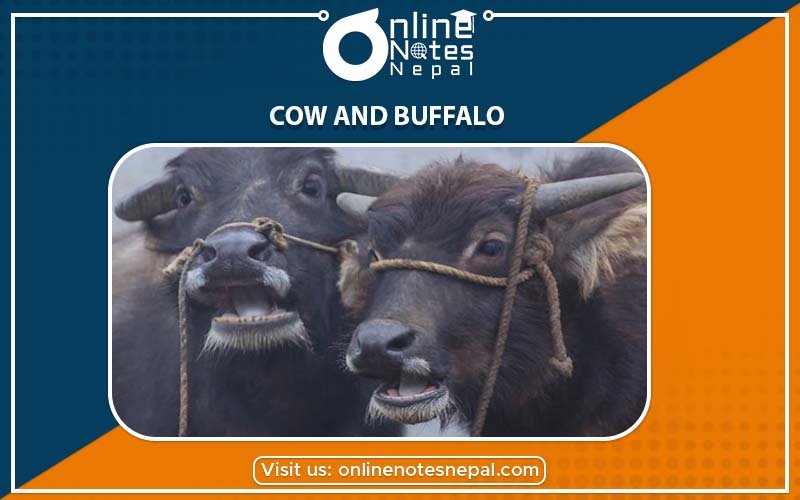Published by: BhumiRaj Timalsina
Published date: 28 Jan 2022

Cow and buffalo farming is very popular in Nepal. It is ancient farming system practiced traditionally all over Nepal. They are farmed in micro scale (few) as well as in large scale. They are kept mainly for milk production. They are the source of generating income. Milk is rich in protein, vitamin and calcium. The production of cow and buffalo depends on the breed, feeding practice, control of diseases and parasites.

There are two types of breeds available in Nepal. They are:
Cows and buffalos are herbivorous animals. They need balanced diet even though they can synthesize some important compounds in their stomach. Providing all kinds of nutrients required for them is their balanced diet. They require carbohydrates, fats, proteins, minerals, vitamins and water. Carbohydrates and fats are required for energy and proteins, minerals, vitamins, and water are required for growth, maintenance and vitality. They can get all these from plants. They eat variety of fodders, plant leaves, hay, grasses, etc. The main sources of food are pasture lands. They can also be given readymade food such as grains, seeds, rice or wheat bran, etc. Plenty of water must be provided as well. The proper amount of vitamins and minerals (balanced diet) are required for the growth and hygiene of the animals. So, the food that is provided should contain all kinds of nutrients.
In the context of Nepal, cattles and buffaloes are left to the natural forest for pasture. It has caused a loss of botanical resources and soil erosion which harms our environment. It is important to manage pasture land in limited areas and conserve the natural forests. A milk giving cow or buffalo can consume about 40 kgs roughages a day. Some grazing land is required in addition to feeding.
Balanced diet for the cattle and buffaloes can be made from local materials. But, it must include all kind of nutrients such as:
We can mix sources of food with water for nutrient during feeding. We can select particular foods and feed. Only water is not enough.
Cows require to mate with bulls or oxen to reproduce. But, in this modern practice, artificial insemination are used on dairy farms. These farms do not keep bulls as it is a cheap and easy method.
The natural way for a cow to have a calf is unassisted in an open field or pasture. After mating, the gestation period is 285 days. After calving, lactation period lasts for 200 days. Heat period starts from about 100 days after calving which lasts for three days and is repeated in 18 days.
After birth, the calf will be ear-tagged or branded for identification and will nurse off its mother's milk for the next 6 to 8 months. Eventually, the calf will start to graze grass alongside its mother until it is weaned from milk entirely.
There are several aspects of production management. First thing is to clarify the objective of cattle and buffalo. It is important due to the following reasons:
Milk: Milk is the main objective of farming cows and buffaloes. The production of milk depends on breeding animals.
Meat: Cows and buffaloes are kept for meat purpose also but it Nepal cattle slaughtering for beef is not allowed by law. However, in Himalayan reason, yak meat is customary in some ethnic groups.
Energy source: Nowadays, dung is processed to produce biogas energy. Dung of animals is also used as rural energy source.
The major aspects of the production management is marketing the products and maintaining the records. The maintenance of technical and financial records is very important. It can show the failure or success of the farming. The ledger account must be kept up to date which includes:
Some common types of diseases and parasites of cattles and buffaloes are as follows:
Bacterial scours: This disease makes the animal weak, the young calf may refuse to suck or drink milk, the intestine fails to absorb fluids, watery discharge takes place and the calf is quickly dehydrated. It is caused by E. Coli and other bacterias. To protect the animals from this disease, they should be protected from rain and muddy area and taking necessary sanitation measures.
Bloat: The animals affected by this disease will have accumulation of gas and foam production, distension of left stomach, stop eating, increased rate of breathing and if it is not cured in time, then the animal may die. It is caused when ruminants feed on legume pasture. It can be cured by making a minor puncture in the paunch or with the medicine like penicillin and anti-bloat preparations in drinking water.
Trichomoniasis: This disease is caused by a protozoan parasite. This may cause cattle to be infertile. This disease causes cattle to refuse mating or there will be slowness in mating. To cure this disease, the animal doctor should be consulted.
Brucellosis: This disease is communicable to human. It is caused by bacteria and is highly infectious. Its symptoms are like the flu symptoms. It causes joint pain, fever, headache etc. Calves can be vaccinated in order to protect them from this disease.
Food and Mouth Disease (FMD): It is caused due to the introduction of improved breeds. The major symptoms of this disease are high fever, sore feet lameness, lesion in the mouth, eating problems, infertility and high mortality of young stock. It can be controlled by vaccination.